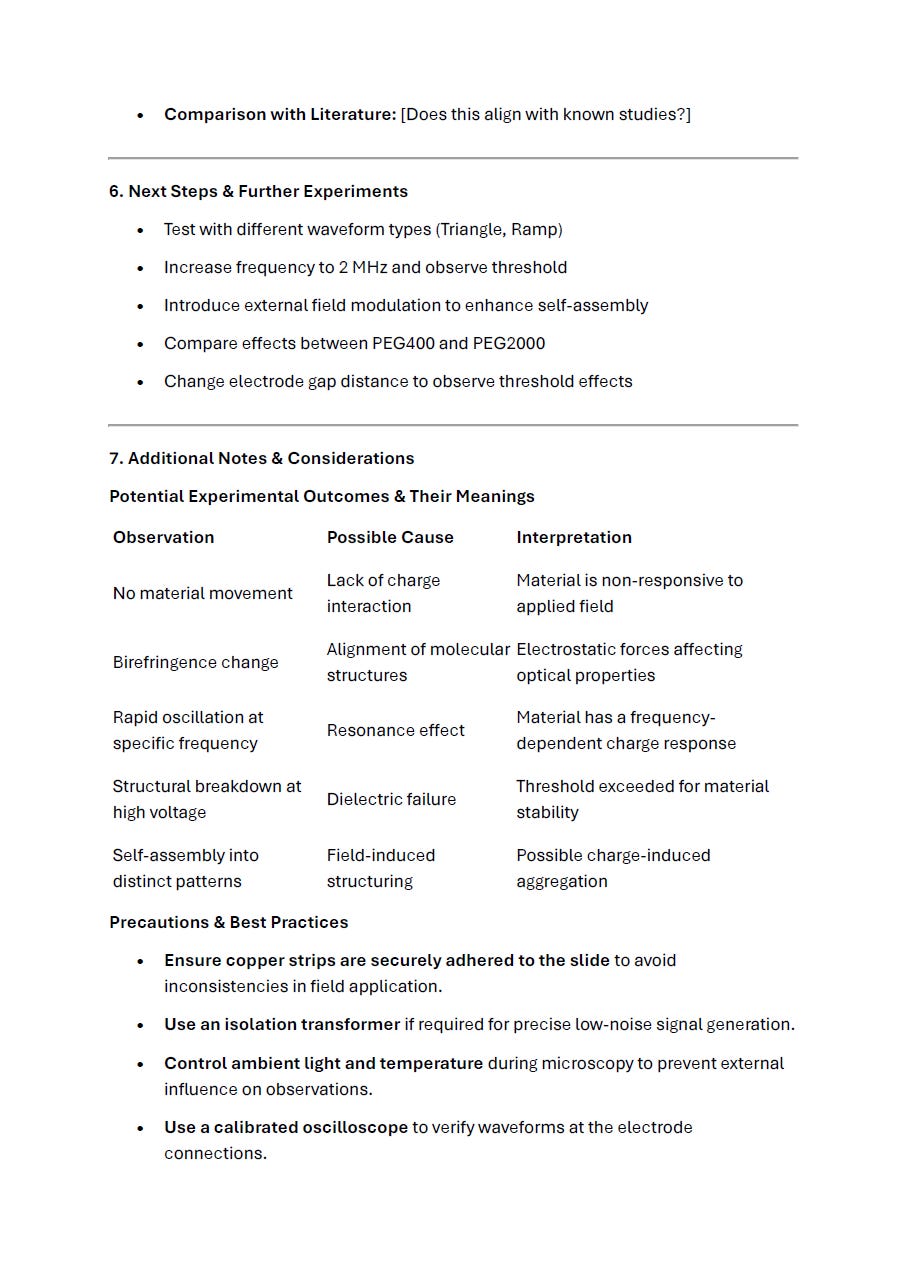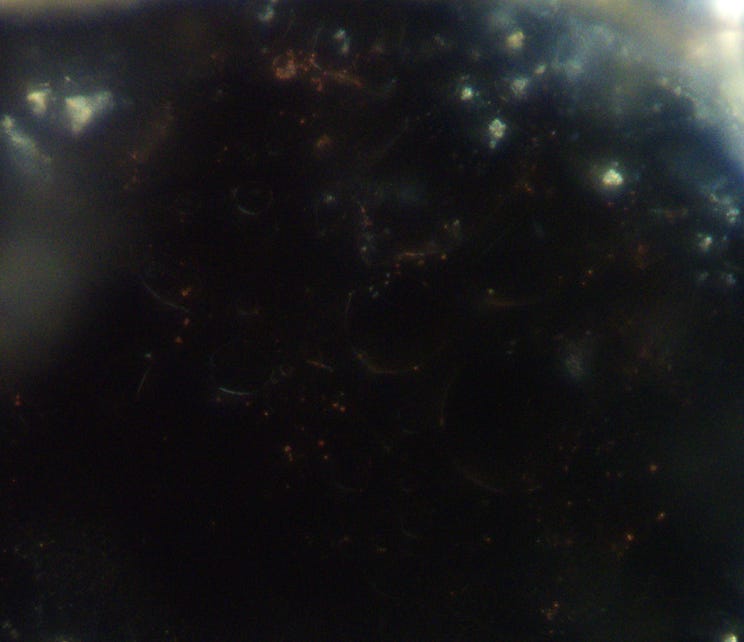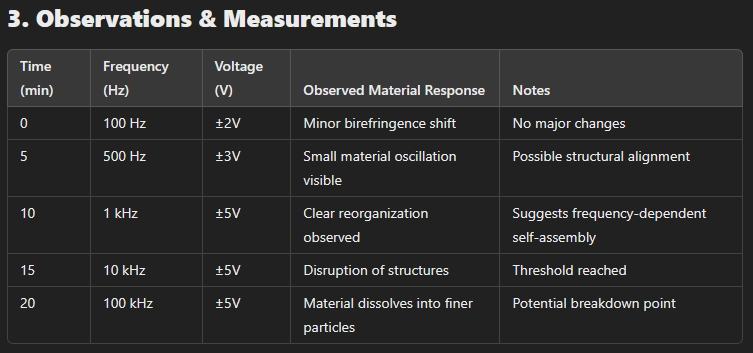Frequency based experiments for those with gear. A proper way to monitor the meaning of frequency and nano material responses.
A function generator, electrical contact slides, Oscilloscope, and microscope!
Work sheets for everyone and a lab experiment that yields useful information. Experimenting with frequency the right way.
Recently while trying to ad every observation I can to papers I decided to look into frequency again. Nano-materials and nano-structures all have known responses to frequency when under certain test conditions. This can be used to aid in correlation for proving a material type is present when used with other observations we have been performing over time. I have just spent a day recently updating the microscope base from scrap wood. Now it has all the custom light source and camera cooling equipment controllers mounted conveniently in the top panel and has far better cooling thanks to the large airflow fan. I purposely decided to make a shelf for other test equipment like the function generator and precision bench meter, as you can see.
An oscilloscope is not needed if you know that your function generator is outputting what it says on the scree readout properly. Mine has a delay on it and the Oscilloscope reads very fast and follows me tuning the frequencies. Most of all, it is important to measure the effective frequencies when yo find them with a calibrated device such as this. So, not essentially, but definitely important for official data logging if you are documenting it for something official.
The slides can be made form fancy metal electrodes, but proper lab grade ones are extremely expensive. These copper adhesive electrodes I have used many times over the years for various experiments. The soldered wire is best to be pure copper and should be soldered using quality solder like the Weller brand i have used here. I use Eco-friendly solder for non critical circuit designs. The extension cable from the function generator has a convenient snap lock cable connector so I can change slides easily. The other end has a banana to BNC connector for the function generator output and for me to attach my oscilloscope probes firmly to confirm frequency via live monitoring.
Now you will notice i have tape on the 20x Leica objective which is holding a half wave polarizer, the other is on the light source so i can cross the polarizers. While we are observing the samples we can also now see any birefringent effects caused by any liquid crystal like materials or other material which changes optical appearance when affected by particular frequencies and wave patterns. This helps not only see any particle or lipid behaviors which could help in identification but also factors which may be effected by these signals. Below is a basic work sheet good enough to do our experiments with and write notes. You may print these and fill them if you have the equipment to do these tests. You are also invited to mail them to me so I can share the results with thanks right here. If you are submitting notes back, please ensure the slides are cleaned thoroughly, images are taken or short video clips of notable phenomenon. Try attach the images with labels and descriptions to the email document so they can be matched to the chart details on page 3.
What are we looking for? There several known interactions where synthetic materials are regarded. Particle movements, crystal manipulation which may show birefringence, structure destruction, and other weird behaviors. So far i have only noted a huge response in the 1-5hz region using square wave at 10volts pk-pk (20volts). Some behaviors will need up to 180v before they can be seen instantaneously in a live sample. Unfortunately my generator only outputs the 10v so either a broadband amplifier is needed after the function generator, or a new function generator. Some output 100vpk-pk without external amplifier. So even this lower power function generator can invoke clear material manipulations if carefully observed. I will upgrade soon but I just got started on this particular side project. Lets see what i observed at 10 v pkpk @1-5hz square wave..
Lignospan using wave generator and polarized filters at 1-5hz square., 10v pkpk.
The video shows that when the waves were applied to the lignospan (dental anesthetic) sample, there was a glowing exhibition of birefringence inside of lipid structures. I will go into this in another post after doing more work myself. But here is one property of use when we go back and evaluate things later. Basically the polarized charged can manipulate the light waves seen through certain kinds of crystalline material.
Around 1hz to 10 ish hz we could see the metal particles being affected by the waves. Even at 10x magnification it is evident that the bipolar pulsing of the signal is shifting these particles perfectly in tandem to the signal, supporting that they have metal property or core. You will notice the bubbles. Gases were produced by the oxidation of the copper contacts, but what is really impressive is that the bubbles are now coated with a bi-layer membrane. The bubbles are passing through the polarized filters with birefringent properties. The membranes clearly have double rings and this is not how a bubble should look at all. It is possible for interference between gases and the lipid rich solution to interact at this stage. It is almost much like nano-templating using just gases themselves
The image above has the gain lowered to prove structural features are both birefringent and that the bubbles now have membranes exactly like bi-layer vesicles. I shall not claim to have studied these effects of gas and lipid formation in too much depth, yet. But certainly a little reading and clear observation suggest there has been a gas-lipid interaction with birefringent bi-layer material detected
This image shows us even more so that the gloopy bubble-like structures coming from the electrode are unusual. A strange relationship can be seen forming between the liquid sample and the gases.
Accelerated assembly of lipid and particle formation could be seen at a couple of frequency numbers so far. Orange fluorescing particles which exhibit birfringence are seen here around lipid domains, they could be seen forming in real time.
So these are examples of what one might expect after brief experiments I shall progress into more. Here are some details of what to expect or look out for in these kinds of experiments.
Yet again I cheated by using chatGPT to find a great starting place from known science. I already have a collection of papers with very specific information regarding these kinds of experiments regarding materials and frequency based molecular manipulation. some of those will require a larger function generator output since I know for certain interactions to be seen they did state 180v was necessary. Anyone participating in this venture will have to do a lot of reading, but it is a very useful technique which if done correctly will offer insight. Using higher power signals on the same setup we may be able to see destructive capabilities which could be used exactly the same on a real RIFE machine of proper design like RIFE himself used. Assuming that frequency isn’t one that our own biology is vulnerable to. It would be foolish to use that frequency if it were to overlap with our healthy systems functioning. People have taken a lot of interest in frequency and how it may be useful. Unfortunately many ideas have shown a lack of understanding regarding they work, how they must be used, and how they can be dangerous, or increase self assembly by using random devices without scientific reasoning and calculation. So far the Square wave at 1 to 5 hz seems to show all the key signs of enhanced self assembly. This would be a similar signal to the spike. ON/OFF every half second or so in the low hurts. The wave would likely be a dirty square wave with large peaks from the electromagnetic device since that is how the relay is pulsing it. So I found this interesting since the spike also does not output very high energy once it penetrates the body. It runs off a very low output power supply. The two experiments are not exact and there are a few variables, but the implications given that electromagnetic field patterns controlled by an OFF/ON relay are known and actually what is to be expected is a similar result. To be destructive to these kinds of materials the EMF would likely need to be far higher and even after I had to have a 45 minute MRI scan over a year ago noticed my blood still looked fairly bad. However, the right studied frequencies may well cause destruction. So the stage is set, and anyone wanting to try learning how RIFE lab experiments can be performed have now got the starting information to tease them into it. I just remembered. Keep your sample wet, use a mix of clean 50/50 sample to saline if temperature is too high or sample evaporates too quickly. Good luck and do share results if you have done a proper and precise job!
AS ALWAYS, thank you for reading and i hope this gives some insight to those who wondered how frequency testing can be done properly.

















Interesting stuff Karl, thank you. 1Khz is about where the fundamentals of the human voice sit BTW. I think this hands on approach to experimentation is the way forward.. all power to you mate.
I'm impressed Karl, and thankful that someone is taking frequence modulation seriously. Of course finding the optimal frequency for the elimination of the foreign substances, is like finding a needle in a stack of needles.
In my opinion a good starting place would be to identify the frequency output of the target elements. Match those frequencies and adjust the intensity of the signal and pulse rate. My concern is that partial destruction of these elements may release the contents (pay load)
causing more damage than good.
Thank you